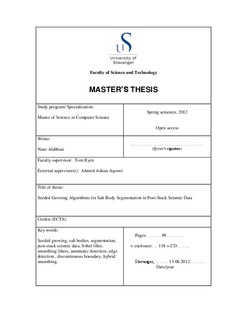| dc.description.abstract | For a more accurate geological model, it is crucial to have proper segmentation
and delineation of structures. Salt structures are known to be difficult to segment
given their chaotic nature; however, there are methods that isolate the
salt borders well. Delineation of salt structures in post stack seismic data is
an inherently di cult problem and is of great value when detecting potential
reservoirs. This is the case in regions such as the Gulf of Mexico. There exist
several approaches where an image ltering algorithm is used to detect such
structures; such is the case with well known seismic attributes like variance, coherence,
amplitude contrast, etc. These attributes usually are a good indication
of the
anks of the salt structure but struggle in segmenting the salt body as a
whole.
In our work, we propose an automated seeded growing method that will segment
the salt bodies from the other structures in seismic data. We Used the edge
volumes as input to get a good indication of the
anks and borders of our
salt structures. We build our method upon the conventional seeded growing
approach, and expand it with hybrid smoothing methods such as median, mean,
Gaussian, adaptive median. Our alternating criteria, in this case, is the amount
of chaos detected. Finally we detected the discontinuous boundary by evaluating
the growing directions of our seed points and terminate based on unbalanced
behavior.
We implemented our method using Matlab and tested it using dataset from the
Gulf of Mexico. By running our algorithm, we got an automated detection of
the seeding within the salt bodies, clear segmentation of the salt bodies and a
termination at the
anks. The results show that even given the noisy nature
of the salt images, the method is able to segment the salt bodies entirely and
consistently. We managed to terminate only at the boundaries of the salt bodies
and not before or after. This gives a more consistent segmentation, which
is evident even in the case where the structures boundaries are disconnected.
Our approach of estimating the boundaries when not present and looking at
unbalanced growing, results in a consistent segmentation nonetheless. Evaluating
all the stages in our algorithm, we nd that the computation complexity is
bounded by O(NlogN)
The approach of a seeded growing algorithm to segment salt bodies proves to
be useful, and given a proper input volume is able to isolate the salt body as a
whole. The approach presented here, with the modi cations, is e ective at this
task only when combined with methods of noise removal/reduction and boundary
termination estimation for existing and discontinuous boundaries. The hybrid
smoothing approach has also proven to be a very useful combination with
the growing method as it alternates smoothing techniques to optimize the segmentation. | no_NO |
